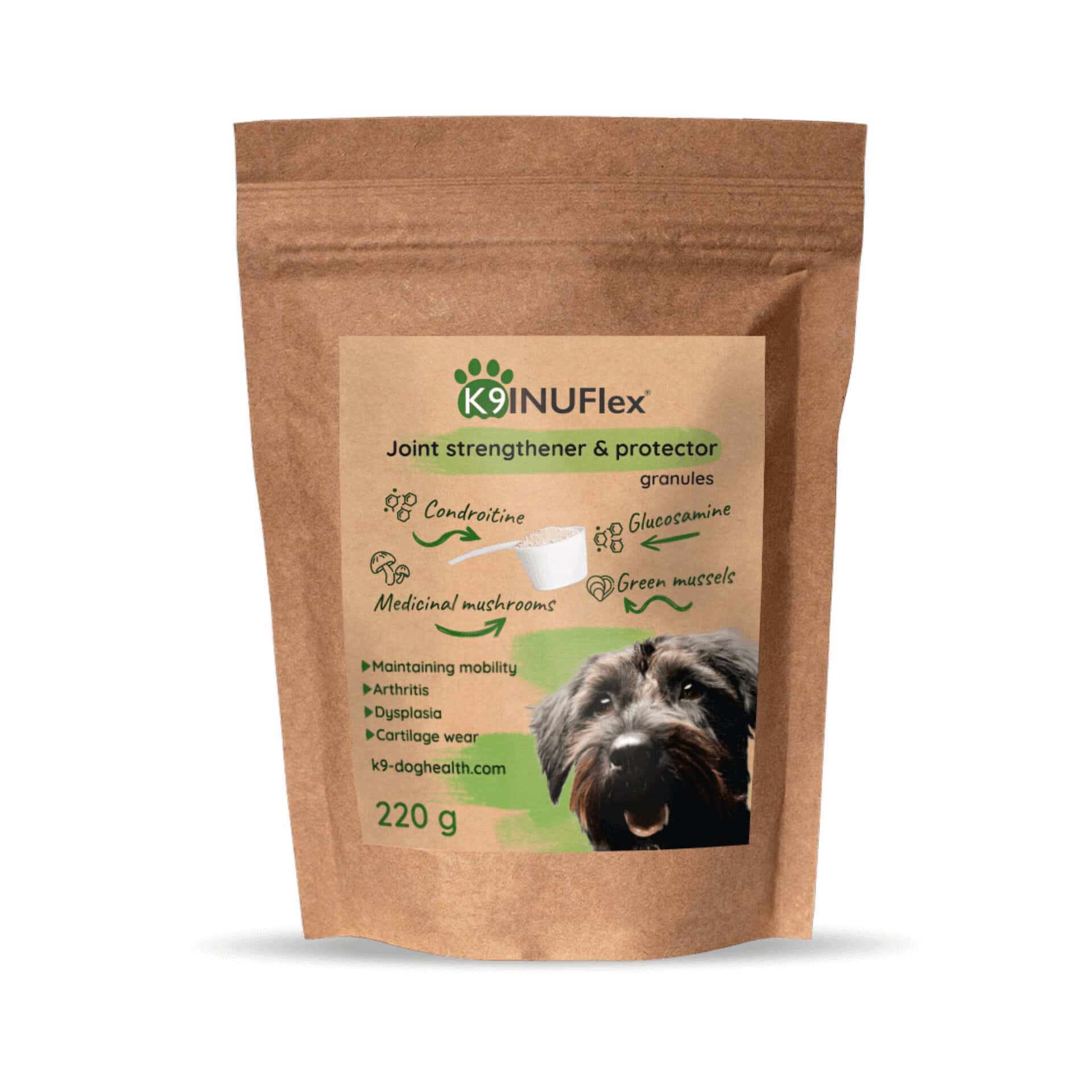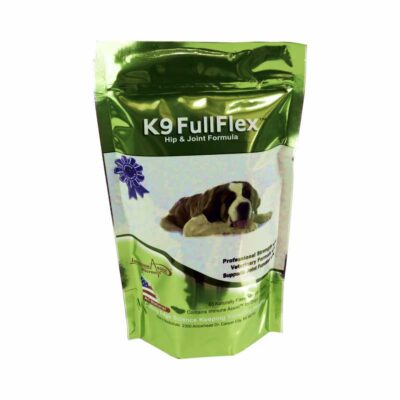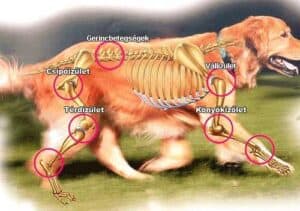
Dysplasia
The dysplasia is a hereditary dog disease, but its symptoms can be alleviated with the right lifestyle, diet and treatment if detected early.
In medical terms, dysplasia means abnormal, pathological development. The bone ends that make up the joints and the cartilage surfaces that cover them fit together imprecisely. Depending on the type and degree of dysplasia, degenerative joint changes (arthrosis), joint sprain (subluxation), and cartilage wear may later develop as a result of an inadequate fit.
Appearance and spread of dysplasia
The dysplasia-type disorder was an unknown concept under natural living conditions (e.g.: jackal, dingo, wolf). And for example in the puli actively working alongside the shepherd a 100 years ago as well. Natural selection and the breeder’s pursuit of work performance created an adequate barrier to the spread of the disease.
However, in recent decades, the way and why of keeping and breeding dogs has changed.
“Pedigree” breeding, incompetent “breeding”, an environment that is too inhospitable for the breed and the needs of the dog, inappropriate feeding and limited space (kennel, flat, narrow yard) have led to a rapid and explosive spread of dysplasia.
The development of dysplasia
Dysplasia is an inherited developmental disorder, not an acquired disease. The recessive (latent) genes responsible for dysplasia are inherited before birth, but the disease cannot be detected immediately after birth. It usually occurs early in the life of puppies (4-6 months).
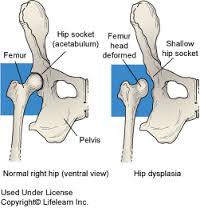
Dysplasia
At the beginning of dysplasia (typically at the age of a few weeks), the synovial fluid increases. This is followed by the relaxation of the joint capsule and the entire joint at the age of a few months. The looser the joint, the more imprecise is the fit of the contacting joint surfaces during movement.
Improperly aligned joints are subjected to multiple forces under load, which makes them sprain more easily. These regular partial sprains initially result in arthritis, later cartilage wear, cartilage deposition (arthrosis), joint formula deformity, and muscle atrophy due to constant pain relief.
Depending on the degree of looseness of the joint and the predisposing factors (feeding, movement), the process damages the joint and leads to the development of bone lesions that can be detected by X-ray examination after months or years.
Symptoms and where it occurs
This condition doesn’t have clear, disease-specific symptoms. A definitive diagnosis can only be made through X-ray imaging. That’s why any suspicious signs should be checked by a veterinarian.
- Weakness of the back half of the body, limping, lameness
- The dog gets up with difficulty, does not like to move, gets tired quickly
- After a difficult start from rest, the joints “warm up” and the movement seems better
- When moving, it places its feet either too close or too far from the ground, with a characteristic “waddling” gait
- When running or jogging, the hind legs do not alternate but touch the ground at the same time. Like jumping a rabbit
- A clicking sound can be heard under the dog’s footsteps while walking
Regarding the forms of dysplasia, we distinguish
- Hip dysplasia – (most often this is simply called dysplasia),
- Elbow dysplasia – (its importance is increasing).
- Shoulder dysplasia – (this is currently even less known)
Grades of dysplasia
It is important to know that when we talk about a dog with dysplasia, we are making a distinction:
- From a breeding point of view, a dog with dysplasia (a dog that carries and inherits the disease, has an inadequate joint structure (can be confirmed by X-ray), but is asymptomatic and does not need medical treatment)
- A dog with clinical dysplasia (a dog that carries and inherits the disease, has an inappropriate joint structure (can also be confirmed by X-ray), has movement disorders due to the disease, is lame and needs treatment)
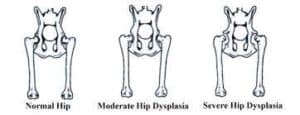
Dysplasia
Grades of dysplasia is primarily a term that arises in relation to dysplasia in the breeder’s sense. In Europe, based on FCI (Federation Cynologique Internationale) recommendations, we distinguish five grades.
Screening
Screening typically takes place in two cases.
- Due to our dog’s movement disorder, when the veterinarian recommends dysplasia screening based on the locomotor examination.
- Preliminary screening for examining the dog’s hip joint, as well as the final dysplasia screening required for dog breeding.
The final certificate, which can also be registered in the pedigree, varies depending on the breed and the regulations of the specific breed club, but is typically 12-24 months old. The existence of a final screening certificate is a basic condition for ethical dog breeding.
Remember that elbow problems in the forelimb are almost as common as hip dysplasia. So if your dog is scheduled for a hip screening, it’s wise to request an elbow evaluation as well. Both checks can be done during the same appointment, reducing the overall risk and cost compared to coming back later for a separate test.
Alleviation of the development and course
One of the most important areas of puppy development is the proper development of bones and joints. This will later provide a healthy, strong skeleton for the internal organs and muscle mass. The developmental dynamics of the first 3 months are crucial for the later development of a stable skeleton and musculature.
Inappropriate feeding (excessive but low in bone-building material) from weaning (4-8 weeks of age), coupled with a poor environment and limited exercise space for the breed and exercise requirements of the dog, significantly increases the risk of dysplasia developing and the severity of its progression.
With this in mind, it is very important to feed puppies correctly and to provide them with the right amount and quality of physical and mental exercise. In truth, whatever the age of your dog, these are basic requirements for a healthy life.
It is recommended that you consult a specialist as soon as possible if you notice any musculoskeletal problems in your dog during growth or at any stage of their life. If the doctor diagnoses dysplasia, the solutions to be used will vary depending on the severity and progression. Please consult the examining doctor for more information.
Treatment of dysplasia
Whatever dysplasia rating our pet has received, it will greatly improve its condition if:
- Body weight is maintained at the ideal level for the breed, with the help of an appropriately modified dysplastic diet, and a satisfactory exercise programme .
>However, it is important to avoid overloading the puppy when moving it, i.e. if it gets tired, do not force the movement. In addition, a sedentary lifestyle is not good either, because the normal development of the gluteal muscles and hip joints requires adequate movement. - We give him a non-steroidal, anti-inflammatory and analgesic supplement rich in natural anti-cartilage substances, such as K9 InuFlex® or K9 FullFlex™.
If a breeding dog has mild dysplasia, it’s not necessarily a serious problem. In some cases, the dog may still be approved for breeding. Mild forms often remain symptom-free throughout the dog’s life.
When moderate dysplasia is diagnosed early, progression can often be slowed down. Proper care from a young age makes a big difference. Symptoms can be managed with medication or joint-supporting supplements. A tailored diet and exercise routine can also help reduce discomfort.
Even in severe cases, there are effective treatment options available. Modern surgeries and alternative methods can improve the dog’s quality of life. One such alternative is golden bead implantation (GBI), used to reduce pain and inflammation.
With proper feeding, moving the dog correctly, and with the right food supplement the chance of developing dysplasia and the aggravation of existing symptoms can be greatly reduced! Click here to read about dysplasia in Hungarian.
One of the most important things we can do to avoid dysplasia is prevention.
